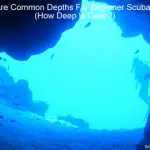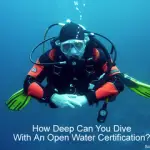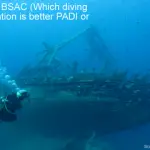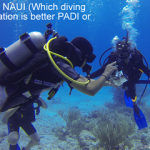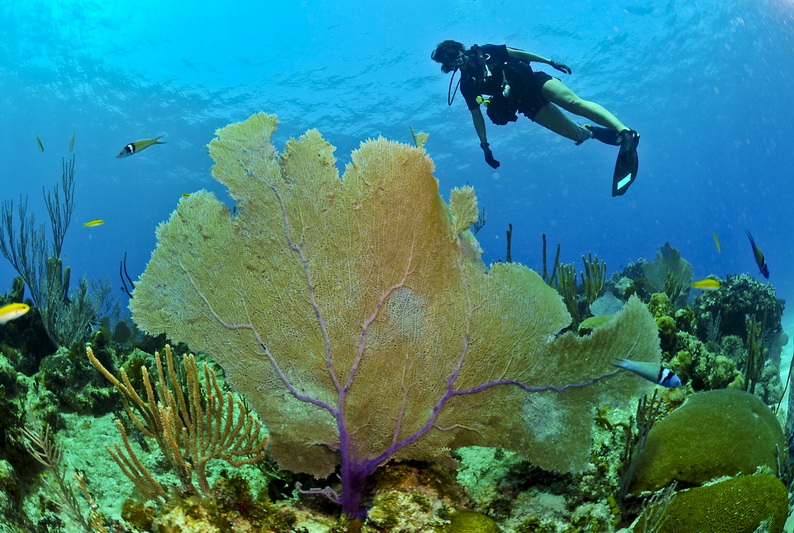
Your reason for asking “how deep can scuba divers dive” maybe because you’re thinking about getting certified as a scuba diver, or perhaps you’ve started your diver training and you’re researching maximum diver depths as you progress with your levels of certification.
Alternatively, you may have been researching a particular dive site, or a particular wreck dive you’d like to dive. Whatever your reason, you should get your answers in this article, and I’ve included a handy table to show the certification levels from four of the top scuba diving organisations.
For the majority of recreational scuba divers the maximum depth you can dive is 40 metres (130 feet), with the exception of BSAC divers who can dive to 50 metres (164 feet). But how deep you can dive depends on which scuba diving organisation you train with and the level of certification you reach.
The best way to do more diving is to book yourself on a scuba diving liveaboard. You can check the latest and best deals on liveaboards using the following window:
Diving deeper considerations
If you intend to dive deeper as a recreational diver, rather than as a technical diver, it’s important you understand the safety considerations. The deeper the dive, the greater the risk.
- Diver certification level: Your scuba diver certification level will determine how deep you can dive, and you are advised to stay within your limits for your own personal safety.
- Number of dives: You should only progress to the next certification level to allow you to enjoy deeper dives once you’ve completed enough dives at your current certification level. It will be up to you how many dives represents “enough dives”, but I suggest you consider how confident you feel as a diver. If you are feeling confident and comfortable diving at your current depth limit and certification, I suggest you can progress, but if you have any doubts or any apprehension you should keep do more dives at your current level.
- Age: How deep you can dive is also limited by your age, for example a 10 year old scuba diver can only diver to 12 metres (40 feet).
- Dive buddy: You should only dive with a dive buddy who is similarly certified to dive to the same depth or higher.
- Last dive recency: If you intend to dive deeper depths, and especially if the depth is deeper than 30 metres (100 feet) where there’s a greater chance of nitrogen narcosis, you should build up your dives beforehand. Never dive to 30+ metres as your first dive if you’ve not dived for more than a few months. But instead you should dive at least one or two shallower dives to 20-25 metres (66-82 feet) first.
- Decompression times: The deeper your dive depth the less time you have before you reach the no-stop decompression dive time limit. All dives are decompression dives, which means you need to decompress slowly as your ascend from depth. But if your dive becomes a decompression stop dive, you will have to perform decompression stops on your way to the surface. Decompression sickness (the Bends) is one of the risks associated with deeper diving, where deep dives are generally accepted to be deeper than 30 metres (100 feet). There are a number of decompression risk factors, and if you want to learn more about these please take a read of this article “14 Decompression Sickness Risk Factors In Scuba Diving and How to Avoid Them“.
- Air consumption: Depth also impacts your air consumption, and the deeper you descend the more air you’ll consume per minute of diving. If you want to learn from my list of pro-tips to conserve air when scuba diving, please take a read of this article too: “Pro Tips To Conserve Air While Scuba Diving“. This article includes 22 pro tips so you can make the most of each air fill, and so you can extend your diving time to as long as possible. I’m over 230lbs which should mean in theory that I consume more air than the average person. But by using these techniques I am able to extend my dive time to match the smaller framed divers around me and enjoy longer dive times at depth**.
- Nitrogen narcosis: A symptom associated with deeper diving is nitrogen narcosis or “The Martini Effect“. Not everyone suffers from nitrogen narcosis, and those that do have varying symptoms. Narcosis (Narks) can range from complete euphoria to anxiety or fear. Nitrogen narcosis can affect you at almost any depth*, but is usually most noticeable at depths below 30 metres (100 feet).
* I recently dived in Barbados with a Canadian diver who suffered from nitrogen narcosis at almost any depth. For example, the maximum depth of our second dive of this particular day, which in this case was the cement plant dive, was around 10 metres (33 feet), and he even came up saying he was “high” on narcosis on this dive, which made me laugh.
** On deeper dives to more than 30 metres (100 feet), I often use a 15 litre dive tank to help extend my dive time too, whilst remaining within the no-stop decompression dive times.
As an aside, in this article about where to find great white sharks, you may be as surprised as I was to discover some of the places where you find great white sharks! Place number 6 is the one that surprised me the most, but if you live in the States, you may be more surprised at places two, three and four.
How deep can scuba divers dive
| Diver Certification | Maximum Recreational Depth | Maximum Diver Depth | Diver Certification Level 1 | Diver Certification Level 2 | Diver Certification Level 3 |
|---|---|---|---|---|---|
| PADI | 40 metres (130 feet) | 40 metres (130 feet) | Open Water Diver - 18 metres (60 feet) | Advanced Open Water Diver - 30 metres (100 feet) | Deep Diver - 40 metres (130 feet) |
| BSAC | 50 metres (164 feet) | 100 metres (328 feet) | Ocean Diver - 20 metres (67 feet) | Sports Diver - 35 metres (115 feet) | Dive leader - 50 metres (164 feet) |
| NAUI | 40 metres (130 feet) | 40 metres (130 feet) | Scuba Diver - 18 metres (60 feet) | Advanced Scuba Diver - 40 metres (130 feet) | Deep Diver - 40 metres (130 feet) |
| SSI | 40 metres (130 feet) | 100 metres (330 feet) | Open Water Diver - 18 metres (60 feet) | Advanced Adventurer - 30 metres (100 feet) | Deep Diving - 40 metres (130 feet) |
How are depth limits set?
Depth limits are set by the diving organisations, including PADI, BSAC, NAUI and SSI, the majority of which begin at 18 metres (60 feet). These depths are set with your safety in mind and it’s usually not recommended to progress to the next level until after you’ve completed 10-20 dives first.
How deep can PADI scuba divers dive
Recreational PADI divers can dive to a maximum of 40 metres (130 feet) as a Deep Diver. But before progressing to Deep Diver level, PADI divers must first certify as an Open Water Diver and then as an Advanced Open Water Diver.
How deep can BSAC scuba divers dive
Recreational BSAC divers can dive to a maximum of 50 metres (164 feet) as a Dive Leader. But before progressing to Dive Leader level, BSAC divers must first certify as an Ocean Diver and then as a Sports Diver.

How deep can NAUI scuba divers dive
Recreational NAUI divers can dive to a maximum of 40 metres (130 feet) as a Deep Diver. But before progressing to Deep Diver level, NAUI divers must first certify as a Scuba Diver and then as an Advanced Scuba Diver.
How deep can SSI scuba divers dive
Recreational SSI divers can dive to a maximum of 40 metres (130 feet) as a Deep Diver. But before progressing to Deep Diver level, SSI divers must first certify as an Open Water Diver and then as an Advanced Adventurer.
Is it safe to exceed depth limits
Depth limits are advisory only, but this doesn’t mean it’s safe to exceed them and is generally not recommended to do so. Having said that, most divers will exceed their certification limit on occasions by a few metres or feet. But it isn’t safe to exceed the depth you have been certified to dive until you’ve had the necessary training first.
In most cases you will be diving with an operator who will want to know your certification level, and they will only take you to dive sites suited to your diving ability and depth certification.
Also, please don’t leave before you watch the video in this article! I almost don’t want to spoil the end of the video, so all I will say is it involves a carcass, many sharks and a single grouper…you may be surprised at what happens, I certainly was!
You may also like this post about “How deep can you scuba dive with Open Water certification“, and this one too “How deep can you scuba dive without decompression“.
I hope you enjoyed this article about how deep can scuba divers dive
I’d love to hear from you. Tell us about your adventures of diving and snorkelling. Please use the comments section below. Please also share your photos. Either from your underwater cameras or videos from your waterproof go-pro’s!
If this article hasn’t answered all of your questions. If you have more questions either about snorkelling or scuba diving (or specifically about how deep can scuba divers dive), please comment below with your questions.
There will also be many more articles about scuba and scuba diving safety tips (and on snorkelling too) for you to read and learn about this fabulous sport.
Have fun and be safe!

